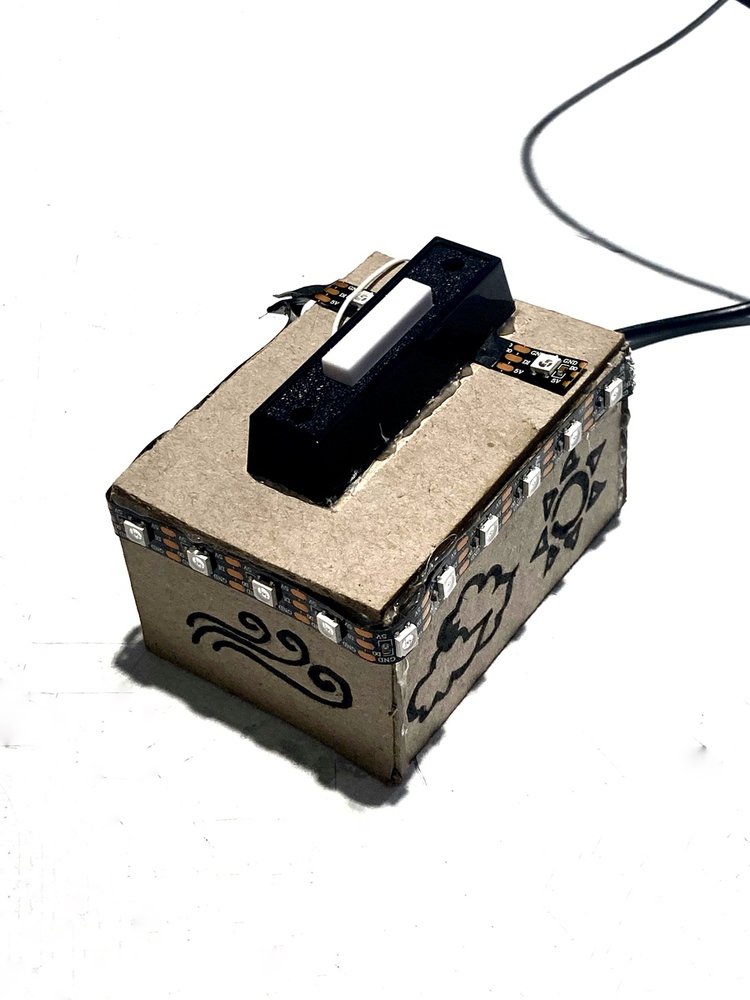Outcome
Context
I drew inspiration broadly from art and design works that challenge anthropocentrism. How can technology be in service of the environment, not just humans? How might technology in a possible future where life is wildly changed by ecological disasters be like? Within the creative constraints of “doorbell, temperature sensor, LED lights,” I felt an elegant way to embody my ideas is through an agentive and sensitive device that knows the weather and atmosphere better than humans, and communicates variations in weather to humans in an emotional way. Ideally, I want the doorbell to be “pressed” by the atmosphere/weather, taking away the agency from humans in that interaction(, which I wasn’t able to implement due to time constraints). I’m also vaguely inspired by a line in Shelley's poem: “If Winter comes, can Spring be far behind?”Prototype/Outcome
I created a doorbell that can show you how it feels about (or predict) tomorrow’s weather. I connect both the LED strip and the doorbell to power sources and digital pins on the Arduino running my code. When someone presses the doorbell, the Arduino reads a 1 from the digital pin and “predicts” tomorrow’s weather based on the current temperature reading. Note that the temperature prediction code is just a Wizard of Oz dummy code rather than a functioning ML model.- Arduino Nano 33 BLE
- LED Strip
- Cardboard
- Doorbell
Process
Open Questions and Next Steps
The aspect of taking away human agency in this interaction remains unresolved, and I’d like to implement servo motors if I have time. The weather prediction algorithm also remains unimplemented. I could actually do more there. Instead of learning how to predict weather from the Pittsburgh weather dataset, the object could have its own idiosyncratic way of foretelling the weather. One big challenge that remains is the fact that this project relies on changes in ambient temperature over time, which poses difficulty for demoing and documentation. A possible solution is to simulate different environments during demo with electronic components like fans.Since this is a rather simple idea, the question of what role such a technology that helps humans connect to the weather can play in a person’s home can be further explored. More iterations and even testing would be beneficial to understand how “animistic” this object actually feels to people.
Reflection
This project is in my opinion not completely successful. I had to abandon the idea of a doorbell being “pressed by weather,” and people still had to initiate the interaction. Part of the reason is the failure to implement a servo motor, but one other reason is that the animistic behavior could be more nuanced and convincing. One opportunity I should explore more is programming more lifelike behavior in the LED strip. For example, following some feedback in class, I realized I could program a “thinking/deciding” behavior by blinking the two LED pixels that resemble eyes. In addition, sound with different emotional qualities is another area I could explore. Prediction of weather conditions such as sunny, cloudy, rainy, etc. would also be clearer and more interesting than “colder” and “warmer,” and since I already have illustrations on the box, I could illuminate the different illustrations to signal the prediction.
Attribution and References
https://github.com/BaptisteZloch/MakeIT-How-to-forecast-weather-with-Arduino-Nano-33
You can upload files of up to 20MB using this form.
